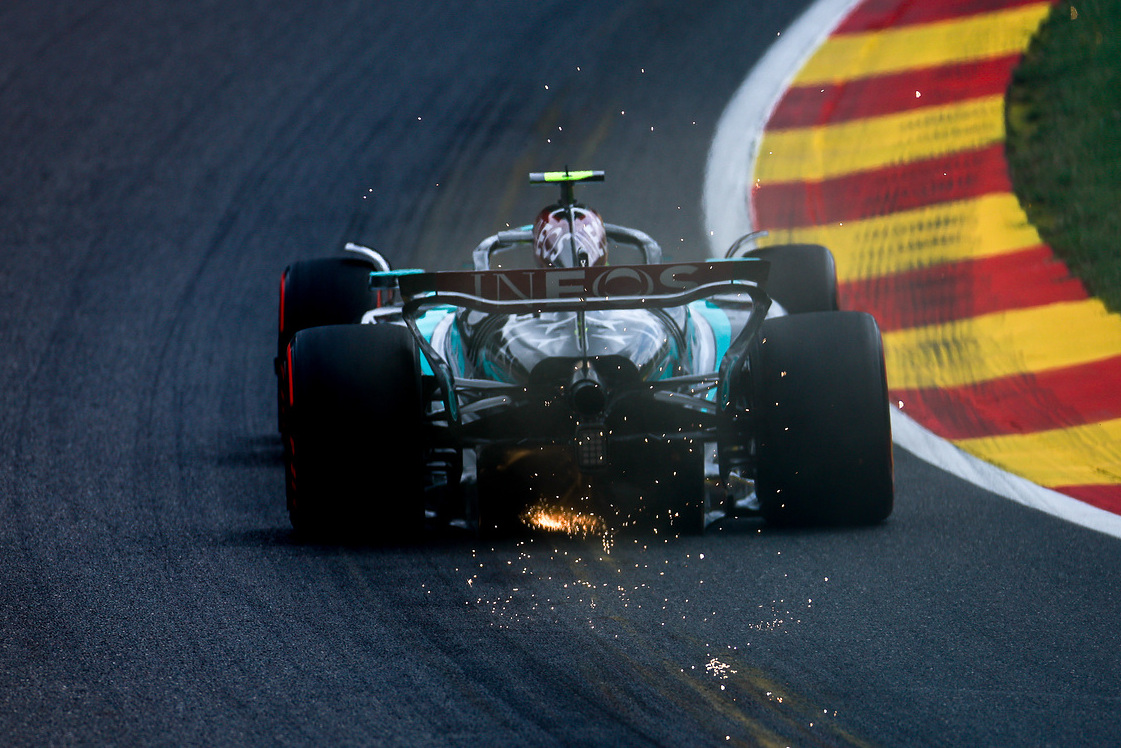Mercedes zeroing in on causes behind Russell’s underweight car
Mercedes is still searching for answers to the unexpected weight loss suffered by George Russell’s car in the Belgian GP, but excessive plank wear has been singled out as one of several potential factors behind the technical infringement.
Russell had executed a brilliant one-stop strategy to cross the checkered flag first, just half a second ahead of his Mercedes teammate Lewis Hamilton.
However, during post-race scrutineering, it was revealed that Russell’s car weighed in 1.5kg underneath Formula 1's minimum weight limit, a technical breach that inevitably compelled the FIA stewards to disqualify the Mercedes contender, handing the win to Hamilton.
In the aftermath of Russell’s disqualification, tyre wear was considered as a possible culprit behind the W15 falling below the weight limit.
Mercedes trackside engineering director Andrew Shovlin has provided a run-down of the probable causes behind the costly infringement, pointing to several factors that collectively could explain why Russell’s car ended the race at Spa lighter than expected.
Read also:
"Obviously, very disappointing and unfortunate, particularly after he'd [George Russell] driven such a strong race to win from so far back," the British engineer said in Mercedes’ Belgian GP debrief video on YouTube.
"Right now we're trying to understand exactly what happened. A lot of that involves us getting the weights of all the different components, and the car can lose quite a lot of weight during the race.
"You get tyre wear, plank wear, brake wear, oil consumption, the drivers themselves can lose a lot, and in this particular race, George lost quite a bit of weight.
“Now, the cars started the race the same weight. Lewis and George were both weighed after qualifying, the cars were within 500 grams.
“George’s was the only one that had the problem and it’s because things like the tyre wear was much higher. It looks like we lost more material on the plank.”

F1’s technical regulations stipulate that plank wear cannot exceed one millimeter during a single race.
As a reminder, Mercedes inadvertently breached this rule last year at the US Grand Prix, which led to Hamilton – and also Ferrari’s Charles Leclerc – being disqualified from the event.
The challenging nature of the Spa-Francorchamps circuit, particularly the high-speed compression through Eau Rouge, exacerbates plank wear.
Russell's one-stop strategy, a decision made during the race rather than a pre-planned tactic, further compounded the issue. As he extended his stint on the hard compound tyre to cover almost three-quarters of the race distance, the plank was subjected to increased stress and wear.
“We'll collect all that data though, look at how we can refine our processes, because clearly we don't want that to happen in the future,” added Shovlin.
The Briton made clear that, while Russell’s car weighed in under the limit, no significant performance advantage was derived from the breach.
“In terms of pace at the start of the race, it’s nil [gain], because George’s car and Lewis’s car started the race at the same weight,” he explained.
Keep up to date with all the F1 news via Facebook and Twitter
The post Mercedes zeroing in on causes behind Russell’s underweight car appeared first on F1i.com.

